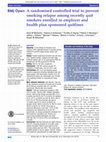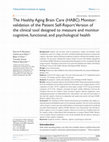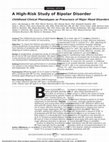Papers by Patrick Monahan

Psychological Medicine, 2015
BackgroundThe first aim was to use confirmatory factor analysis (CFA) to test a hypothesis that t... more BackgroundThe first aim was to use confirmatory factor analysis (CFA) to test a hypothesis that two factors (internalizing and externalizing) account for lifetime co-morbid DSM-IV diagnoses among adults with bipolar I (BPI) disorder. The second aim was to use confirmatory latent class analysis (CLCA) to test the hypothesis that four clinical subtypes are detectible: pure BPI; BPI plus internalizing disorders only; BPI plus externalizing disorders only; and BPI plus internalizing and externalizing disorders.MethodA cohort of 699 multiplex BPI families was studied, ascertained and assessed (1998–2003) by the National Institute of Mental Health Genetics Initiative Bipolar Consortium: 1156 with BPI disorder (504 adult probands; 594 first-degree relatives; and 58 more distant relatives) and 563 first-degree relatives without BPI. Best-estimate consensus DSM-IV diagnoses were based on structured interviews, family history and medical records. MPLUS software was used for CFA and CLCA.Resul...

BMJ open, 2015
To test adding an interactive voice response (IVR)-supported protocol to standard quitline treatm... more To test adding an interactive voice response (IVR)-supported protocol to standard quitline treatment to prevent relapse among recently quit smokers. Parallel randomised controlled trial with three arms: standard quitline, standard plus technology enhanced quitline with 10 risk assessments (TEQ-10), standard plus 20 TEQ assessments (TEQ-20). Quit For Life (QFL) programme. 1785 QFL enrolees through 19 employers or health plans who were 24+ h quit. QFL is a 5-call telephone-based cessation programme including medications and web-based support. TEQ interventions included 10 or 20 IVR-delivered relapse risk assessments over 8 weeks with automated transfer to counselling for those at risk. Self-reported 7-day and 30-day abstinence assessed at 6-month and 12-month post-enrolment (response rates: 61% and 59%, respectively). Missing data were imputed. 1785 were randomised (standard n=592, TEQ-10 n=602, TEQ-20 n=591). Multiple imputation-derived, intent-to-treat 30-day quit rates (95% CI) at ...

Journal of Clinical Epidemiology, 2015
Measures for assessing patient-reported outcomes (PROs) that may have initially been developed fo... more Measures for assessing patient-reported outcomes (PROs) that may have initially been developed for research are increasingly being recommended for use in clinical practice as well. Although psychometric rigor is essential, this article focuses on pragmatic characteristics of PROs that may enhance uptake into clinical practice. Three sources were drawn on in identifying pragmatic criteria for PROs: (1) selected literature review including recommendations by other expert groups; (2) key features of several model public domain PROs; and (3) the authors' experience in developing practical PROs. Eight characteristics of a practical PRO include: (1) actionability (i.e., scores guide diagnostic or therapeutic actions/decision making); (2) appropriateness for the relevant clinical setting; (3) universality (i.e., for screening, severity assessment, and monitoring across multiple conditions); (4) self-administration; (5) item features (number of items and bundling issues); (6) response options (option number and dimensions, uniform vs. varying options, time frame, intervals between options); (7) scoring (simplicity and interpretability); and (8) accessibility (nonproprietary, downloadable, available in different languages and for vulnerable groups, and incorporated into electronic health records). Balancing psychometric and pragmatic factors in the development of PROs is important for accelerating the incorporation of PROs into clinical practice.

Journal of Educational Measurement, 2005
Empirical studies demonstrated Type-I error (TIE) inflation (especially for highly discriminating... more Empirical studies demonstrated Type-I error (TIE) inflation (especially for highly discriminating easy items) of the Mantel-Haenszel chi-square test for differential item functioning (DIF), when data conformed to item response theory (IRT) models more complex than Rasch, and when IRT proficiency distributions differed only in means. However, no published study manipulated proficiency variance ratio (VR). Data were generated with the three-parameter logistic (3PL) IRT model. Proficiency VRs were 1, 2, 3, and 4. The present study suggests inflation may be greater, and may affect all highly discriminating items (low, moderate, and high difficulty), when IRT proficiency distributions of reference and focal groups differ also in variances. Inflation was greatest on the 21-item test (vs. 41) and 2,000 total sample size (vs. 1,000). Previous studies had not systematically examined sample size ratio. Sample size ratio of 1:1 produced greater TIE inflation than 3:1, but primarily for total sample size of 2,000.
Journal of Educational Measurement, 2007
A Monte Carlo simulation technique for generating dichotomous item scores is presented that imple... more A Monte Carlo simulation technique for generating dichotomous item scores is presented that implements (a) a psychometric model with different explicit assumptions than traditional parametric item response theory (IRT) models, and (b) item characteristic curves without restrictive assumptions concerning mathematical form. The four-parameter beta compound-binomial (4PBCB) strong true score model (with two-term approximation to the compound binomial) is used to estimate and generate the true score distribution. The nonparametric item-true score step functions are estimated by classical item difficulties conditional on proportion-correct total score.

Health education research, Jan 28, 2015
To compare the efficacy of two interventions to promote colorectal cancer screening participation... more To compare the efficacy of two interventions to promote colorectal cancer screening participation and forward stage movement of colorectal cancer screening adoption among first-degree relatives of individuals diagnosed with adenomatous polyps. One hundred fifty-eight first-degree relatives of individuals diagnosed with adenomatous polyps were randomly assigned to receive one of two interventions to promote colorectal cancer screening. Participants received either a tailored telephone counseling plus brochures intervention or a non-tailored print brochures intervention. Data were collected at baseline and 3 months post-baseline. Group differences and the effect of the interventions on adherence and stage movement for colorectal cancer screening were examined using t-tests, chi-square tests, and logistic regression. Individuals in the tailored telephone counseling plus brochures group were significantly more likely to complete colorectal cancer screening and to move forward on stage o...

Journal of Aging Research, 2015
Objective. To understand older primary care patients&... more Objective. To understand older primary care patients' perceptions of the risks and benefits of dementia screening and to measure the association between attitudes and screening behaviors. Methods. Eligible patients completed the Perceptions Regarding Investigational Screening for Memory in Primary Care (PRISM-PC) questionnaire and then were asked to undergo dementia screening by a telephone screening instrument. Results. Higher scores on the PRISM-PC questionnaire items that measure attitudes about benefits of screening were associated with decreased odds of refusing screening. Participants who refused screening had significantly lower PRISM-PC questionnaire scores on the items that measure perceived benefits compared to those who agreed to screening. Participants who refused screening were less likely to agree on screening for other conditions, such as depression and cancer. Participants who know someone with Alzheimer's disease (AD) were less likely to refuse screening. Discussion. Patients' attitudes about the benefits of dementia screening are associated with their acceptance of dementia screening.

The oncologist, 2007
Although venlafaxine reduces self-reported hot flashes, no data have established the drug's i... more Although venlafaxine reduces self-reported hot flashes, no data have established the drug's impact on physiologically documented hot flashes. Two randomized, double-blind, placebo-controlled crossover trials examined the efficacy of two doses of venlafaxine in relation to physiological and self-reported hot flashes and other outcomes, including negative affect, fatigue, sleep, and quality of life. 57 breast cancer survivors in the low-dose study; 20 in the high-dose study. university cancer clinics in the Southeast and Midwest. 37.5 mg of venlafaxine (low-dose study) or 75 mg of venlafaxine (high-dose study). hot flash frequency (physiological monitor, diary, and event marker), hot flash severity (diary), hot flash bother (diary), and questionnaires for hot flash impact on daily life, negative affect, fatigue, sleep, and quality of life. Subjective but not physiological hot flash measures showed placebo effects. Venlafaxine resulted in modest decreases in hot flashes, but only h...

Clinical interventions in aging, 2014
Primary care providers need an inexpensive, simple, user-friendly, easily standardized, sensitive... more Primary care providers need an inexpensive, simple, user-friendly, easily standardized, sensitive to change, and widely available multidomain instrument to measure the cognitive, functional, and psychological symptoms of patients suffering from multiple chronic conditions. We previously validated the Caregiver Report Version of the Healthy Aging Brain Care Monitor (HABC Monitor) for measuring and monitoring the severity of symptoms through caregiver reports. The purpose of this study was to assess the reliability and validity of the Patient Self-Report Version of the HABC Monitor (Self-Report HABC Monitor). Cross-sectional study. Primary care clinics affiliated with a safety net urban health care system in Indianapolis, Indiana, USA. A total of 291 subjects aged ≥65 years with a mean age of 72.7 (standard deviation 6.2) years, 76% female, and 56% African Americans. Psychometric validity and reliability of the Self-Report HABC Monitor. Among 291 patients analyzed, the Self-Report HAB...
Applied Measurement in Education, 2008
This article introduces a bootstrap generalization to the Modified Parallel Analysis (MPA) method... more This article introduces a bootstrap generalization to the Modified Parallel Analysis (MPA) method of test dimensionality assessment using factor analysis. This methodology, based on the use of Marginal Maximum Likelihood nonlinear factor analysis, provides for the calculation of a test statistic based on a parametric bootstrap using the MPA methodology for generation of synthetic datasets. Performance of the bootstrap test
J Ment Health, 2008
... Enbal Shacham, PhD 1 , Michael Reece 2 , Patrick O. Monahan 3 , Violet Yebei 4 , 5 ... Hann... more ... Enbal Shacham, PhD 1 , Michael Reece 2 , Patrick O. Monahan 3 , Violet Yebei 4 , 5 ... Hannan TJ, Tierney WM, Rotich JK, Smith FE, Bii J., Einterz RM, Mamlin JJ, Odero WW, Diero L. Technological and human factors affecting the utilization of a CBPR system in western Kenya. ...

Oncology Nursing Forum, 2005
To evaluate the effectiveness of a cognitive behavioral intervention in decreasing symptom severi... more To evaluate the effectiveness of a cognitive behavioral intervention in decreasing symptom severity in patients with advanced cancer undergoing chemotherapy. Prospective, randomized clinical trial based on cognitive behavioral theory. Six urban cancer centers in the midwestern United States. 124 patients 21 years of age or older were recruited and randomized to receive conventional care or conventional care and an intervention. Participants were newly diagnosed with stage III, stage IV, or recurrent cancer (solid tumor or non-Hodgkin lymphoma), undergoing chemotherapy, cognitively intact, and able to read and speak English. Data were gathered via telephone interviews at baseline and 10 and 20 weeks after randomization. Nurses with experience in oncology delivered a five-contact, eight-week intervention aimed at teaching patients problem-solving techniques to affect symptom severity. Gender, site of cancer, age, symptom severity and depressive symptoms at baseline, group (i.e., experimental versus control), and total symptom severity. Patients in the experimental group and those with lower symptom severity at baseline had significantly lower symptom severity at 10 and 20 weeks; the experimental difference at 20 weeks occurred primarily in those 60 years of age and younger. Depressive symptoms at baseline predicted symptom severity at 20 weeks; however, age, gender, and site of cancer did not affect symptom severity at either time point. A cognitive behavioral intervention to teach problem-solving skills can be effective for patient symptom self-management during and following an intervention. Problem-solving strategies should be included in educational programs for patients with advanced cancer, particularly those 60 years of age and younger.
Sexual Addiction & Compulsivity, 2009
This study explored possible associations between two personal tendencies “sexual compulsivity” a... more This study explored possible associations between two personal tendencies “sexual compulsivity” and “sexual sensation seeking,” and self-esteem, family environmental conditions and sexual abuse experiences during childhood in a sample of 539 young adults in a mid-western university. A cross-sectional survey design was employed and data were collected using self-report, anonymous questionnaires. Men scored higher on the measures of sexual compulsivity
Journal of health psychology, Jan 28, 2014
The purpose of this study was to test an intervention to increase mammography screening in women ... more The purpose of this study was to test an intervention to increase mammography screening in women 51-75 years of age who had not received a mammogram in the last 15 months. A total of 1681 women were randomized to (1) a mailed tailored interactive DVD, (2) a computer-tailored telephone counseling, or (3) usual care. Women with income below US$75,000 who were in the interactive DVD group had significantly more mammograms than women in usual care. Women with income above US$75,000 had significantly fewer mammograms than women with income less than US$75,000 regardless of group. Further investigation is needed to understand why women with income above US$75,000 did not show the same benefit of the intervention.

Archives of general psychiatry, 2011
The childhood precursors of adult bipolar disorder (BP) are still a matter of controversy. To rep... more The childhood precursors of adult bipolar disorder (BP) are still a matter of controversy. To report the lifetime prevalence and early clinical predictors of psychiatric disorders in offspring from families of probands with DSM-IV BP compared with offspring of control subjects. A longitudinal, prospective study of individuals at risk for BP and related disorders. We report initial (cross-sectional and retrospective) diagnostic and clinical characteristics following best-estimate procedures. Assessment was performed at 4 university medical centers in the United States between June 1, 2006, and September 30, 2009. Offspring aged 12 to 21 years in families with a proband with BP (n = 141, designated as cases) and similarly aged offspring of control parents (n = 91). Lifetime DSM-IV diagnosis of a major affective disorder (BP type I; schizoaffective disorder, bipolar type; BP type II; or major depression). At a mean age of 17 years, cases showed a 23.4% lifetime prevalence of major affe...

Annals of Clinical Psychiatry, 1997
We sought to determine variables predictive of outcome in a group of 45 men with antisocial perso... more We sought to determine variables predictive of outcome in a group of 45 men with antisocial personality disorder followed up a mean of 29 years following hospitalization. Based on personal interviews, interviews with informants, and medical and legal records, sufficient information was available to rate the global outcome in 45 men. The Global Assessment Scale (GAS) was also used to measure functioning in 44 men at intake and follow-up. Twenty-six (57.8%) were rated as having "any improvement." Univariate analysis showed men experiencing improvement were more likely to have high GAS scores at intake, were not currently alcoholic, were older, and were followed over a longer period of time. Low GAS scores at intake and the interaction between the GAS score at intake and current alcoholism independently predicted poor outcome on regression analysis. A low GAS score at intake and shorter follow-up also independently predicted poor outcome, even though stepwise regression revealed the strongest single predictor to be the interaction between the initial GAS score and age at follow-up. In summary, long-term outcome in antisocial males is associated with an initial level of severity, alcohol consumption at follow-up, and both age at follow-up and length of follow-up. Initial severity best predicts outcome among men not currently alcoholic who have been followed over a long period of time.

Journal of the National Cancer Institute. Monographs, 2010
Screening has become one of our best tools for early detection and prevention of cancer. The grou... more Screening has become one of our best tools for early detection and prevention of cancer. The group-randomized trial is the most rigorous experimental design for evaluating multilevel interventions. However, identifying the proper sample size for a group-randomized trial requires reliable estimates of intraclass correlation (ICC) for screening outcomes, which are not available to researchers. We present crude and adjusted ICC estimates for cancer screening outcomes for various levels of aggregation (physician, clinic, and county) and provide an example of how these ICC estimates may be used in the design of a future trial. Investigators working in the area of cancer screening were contacted and asked to provide crude and adjusted ICC estimates using the analysis of variance method estimator. Of the 29 investigators identified, estimates were obtained from 10 investigators who had relevant data. ICC estimates were calculated from 13 different studies, with more than half of the studie...
Annals of Clinical Psychiatry, 1995
The authors studied 75 outpatients with DSM-III-R panic disorder who had participated in a clinic... more The authors studied 75 outpatients with DSM-III-R panic disorder who had participated in a clinical trial and had been randomly assigned to receive fluvoxamine, cognitive therapy, or placebo for an 8-week period. They compared a group with high levels of depressive symptoms and a group with low levels of depressive symptoms. At baseline, patients with high levels of depressive symptoms were more likely to have severe phobic avoidance and to have higher scores on measures of anxiety, hyochondriasis, and disability. An important finding was that depressive symptoms improved at a rate which paralleled improvement in panic and anxiety. Likewise, the presence of depressive symptoms did not interfere with treatment response in panic disorder. Clinical implications of the findings are discussed.

Uploads
Papers by Patrick Monahan